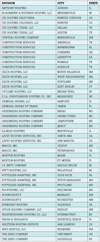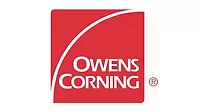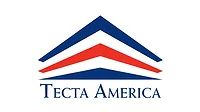No. 1: Tecta America Thrives on Teamwork
Mark Santacrose, President and CEO of Tecta America Corp., knows the benefits of teamwork. Tecta America is made up of 3,000 roofing professionals working in some 50 locations, reporting to a corporate headquarters in Skokie, Ill.

Mark Santacrose, President and CEO of Tecta America Corp., knows the benefits of teamwork. Tecta America is made up of 3,000 roofing professionals working in some 50 locations, reporting to a corporate headquarters in Skokie, Ill.
Its 29 operating units are each independent profit centers, but Santacrose is quick to point out that Tecta America is one entity with a common goal: to provide the most comprehensive roofing program in the country and meet and exceed its customers’ needs.
“It’s important for people to understand that we’re a single company,” he said. “Tecta America owns all of our operating units. From a marketing standpoint each local name has great value in its own market, but all are co-branded as a Tecta America Company.”
 According to Santacrose, decisions are made at the local level, allowing the operating units the flexibility to adapt to their specific markets, but uniting them when needed to strengthen their combined resources. Five of the divisions are union shops; the others are non-union. “Market needs differ, and we want to excel in each type of market,” he said. “We want to handle union and non-union work. We support both.”
According to Santacrose, decisions are made at the local level, allowing the operating units the flexibility to adapt to their specific markets, but uniting them when needed to strengthen their combined resources. Five of the divisions are union shops; the others are non-union. “Market needs differ, and we want to excel in each type of market,” he said. “We want to handle union and non-union work. We support both.”
The performance of each unit is measured rigorously, said Santacrose, but overall company performance is the true bottom line. “Because we’re all shareholders in Tecta America, every unit is competitive with the others, but financial incentives are at the Tecta level, so the company has to perform well as a whole. So, if we have to pour resources from one area into another area, everyone knows we’re working together.”
This cooperation results in a company that can do it all, according to Santacrose. “We can install any roof system on any roof, wherever it’s located in the country, at any time,” he said. “We have deep relationships with every manufacturer out there. We have over 3,000 employees, and we can and do deploy them as needed. We can marshal our response very quickly in the event of a disaster.”

Hoping to expand its services on these trends, the company recently launched a new division, Tecta Solar. It works with all of Tecta’s operating units on the design, engineering, financing, and installation of solar systems, as well as operation, maintenance, warranties, and performance monitoring.
“We have a two-pronged approach to the economy: tighten our belts wherever we can but invest for the long term,” said Santacrose. “Solar is a great area in which to invest, so we launched Tecta Solar.”
Financial decisions in solar projects are complex, noted Santacrose, and tax incentives can often make or break a project. Expert advice is crucial. “We have people who understand complex legal, tax and financial incentives, as well as construction,” he said. “I think the roof as a solar installation component has been undervalued, and we want to make sure a photovoltaic system is well integrated and offers the best value to the end user. We’re deeply experienced with 20-year-plus systems. A solar panel lasts 25 years, so installation day is not the time to make a decision on how cheaply a roof can be installed. We have to explain that value to the building owner and explain how roof and solar are installed to complement each other.”
 To help design vegetative roofs, Tecta’s Green Roof service is run by a horticulturist, who will pick plants that will thrive in the area. Vegetative systems are prominent components in recent high-profile Tecta projects including a 2.5-acre green roof under construction at the Target Center in Minneapolis, home of the NBA’s Minnesota Timberwolves.
To help design vegetative roofs, Tecta’s Green Roof service is run by a horticulturist, who will pick plants that will thrive in the area. Vegetative systems are prominent components in recent high-profile Tecta projects including a 2.5-acre green roof under construction at the Target Center in Minneapolis, home of the NBA’s Minnesota Timberwolves.
Recently completed high-profile projects include a solar installation on the Staples Center in Southern California; a green roof on the Federal Reserve Bank’s Charlotte branch; a vegetative roof on a Social Security building in Birmingham, Ala.; and a green roof on a U.S. Postal Service distribution center in midtown Manhattan. Other prominent projects include work on the Buddhist Cultural Center in Washington and re-roofing the U.S. Supreme Court building.
The last project has special significance for Santacrose, who holds a law degree from Loyola University as well as an accounting degree from Marquette University and a M.B.A. from Northwestern University’s Kellogg School of Business. “Every lawyer’s dream is to practice before the Supreme Court,” he said. “I didn’t realize that dream, but at least we’re working on top of the Supreme Court.”

Not surprisingly, roofing business is down this year for Tecta America, especially in the Southeast, with Florida the toughest market right now. “We did an analysis recently of our 29 operating units, and year-to-date half of them are up and half are down,” Santacrose said. “But the ones that are up are up a little, and the ones that are down are down a lot. Given the fragmented nature of the industry, people can have good years, but much like the industry as a whole, we’re down.”
The good news for roofing contractors is that roofs will always be in demand. “Roof assets continue to deteriorate; it’s the nature of the beast,” said Santacrose. “Despite the financial market, demand continues to build.”
Regardless of the economic climate, it’s always important to stress the fundamentals. “Whether you’re in an up or a down market, your reputation matters,” Santacrose said. “And your reputation starts with people - the people on the job. Your people are the most important thing. Customers are risk-averse, and they want to make sure their contractor will be around. So financial strength, reputation and quality of work are essential. They want to know you’ll be around.”
Santacrose cites another key element in Tecta America’s success: its commitment to safety. “Our operation starts with safety,” he said. “We invest more money, training and equipment in safety than anyone else out there. With our EMR (Experience Modification Rate) at around 0.5 we consistently lead the industry in safety, and have for years, despite 20 acquisitions. Safety is important for our people - most importantly, you want your people to go home safely at night - and it also affects financing and insurance costs.”
But there’s more to it than that, noted Santacrose: “Safety is also a key indicator of quality. How do you ensure you’re doing good work, and how do you prove it to building owners - especially with 20 years between projects? It’s hard to evaluate that. But how you perform with respect to safety is a real indication of how you manage your people, the level of training provided to them, and many other factors that add up to a quality job. Safety numbers must be recorded and reported to insurance companies. If you do all those little things right, it’s going to show up in your safety numbers.”
For more information about Tecta America, visit www.tectaamerica.com.

Marquee projects currently under way for Tecta America include the installation of a 2.5-acre vegetative roof on the Target Center in Minneapolis. Photos courtesy of Tecta America Corp. (Wiese Photo)
Mark Santacrose, President and CEO of Tecta America Corp., knows the benefits of teamwork. Tecta America is made up of 3,000 roofing professionals working in some 50 locations, reporting to a corporate headquarters in Skokie, Ill.
Its 29 operating units are each independent profit centers, but Santacrose is quick to point out that Tecta America is one entity with a common goal: to provide the most comprehensive roofing program in the country and meet and exceed its customers’ needs.
“It’s important for people to understand that we’re a single company,” he said. “Tecta America owns all of our operating units. From a marketing standpoint each local name has great value in its own market, but all are co-branded as a Tecta America Company.”

Warren Stock, President of Stock Roofing, a Tecta America Company, is shown on site at the Target Center.
The performance of each unit is measured rigorously, said Santacrose, but overall company performance is the true bottom line. “Because we’re all shareholders in Tecta America, every unit is competitive with the others, but financial incentives are at the Tecta level, so the company has to perform well as a whole. So, if we have to pour resources from one area into another area, everyone knows we’re working together.”
This cooperation results in a company that can do it all, according to Santacrose. “We can install any roof system on any roof, wherever it’s located in the country, at any time,” he said. “We have deep relationships with every manufacturer out there. We have over 3,000 employees, and we can and do deploy them as needed. We can marshal our response very quickly in the event of a disaster.”

Solar Systems, Garden Roofs
Although the economy has been shaky, Santacrose looks for solar and green roofs to continue to gain momentum. “We’re still seeking growth,” he said. “The political landscape is focused on climate change and the environment, and that’s still a driver of these decisions despite the economy. The economy has made it tougher to finalize financing, for example. But the interest level is stronger than ever. There is tremendous interest in the whole environmentally friendly movement.”Hoping to expand its services on these trends, the company recently launched a new division, Tecta Solar. It works with all of Tecta’s operating units on the design, engineering, financing, and installation of solar systems, as well as operation, maintenance, warranties, and performance monitoring.
“We have a two-pronged approach to the economy: tighten our belts wherever we can but invest for the long term,” said Santacrose. “Solar is a great area in which to invest, so we launched Tecta Solar.”
Financial decisions in solar projects are complex, noted Santacrose, and tax incentives can often make or break a project. Expert advice is crucial. “We have people who understand complex legal, tax and financial incentives, as well as construction,” he said. “I think the roof as a solar installation component has been undervalued, and we want to make sure a photovoltaic system is well integrated and offers the best value to the end user. We’re deeply experienced with 20-year-plus systems. A solar panel lasts 25 years, so installation day is not the time to make a decision on how cheaply a roof can be installed. We have to explain that value to the building owner and explain how roof and solar are installed to complement each other.”

Tecta America offers the services of a horticulturist to select plants that will thrive in a given area and an Energy and Environmental Solutions Manager to design daylighting systems for maximum efficiency.
Recently completed high-profile projects include a solar installation on the Staples Center in Southern California; a green roof on the Federal Reserve Bank’s Charlotte branch; a vegetative roof on a Social Security building in Birmingham, Ala.; and a green roof on a U.S. Postal Service distribution center in midtown Manhattan. Other prominent projects include work on the Buddhist Cultural Center in Washington and re-roofing the U.S. Supreme Court building.
The last project has special significance for Santacrose, who holds a law degree from Loyola University as well as an accounting degree from Marquette University and a M.B.A. from Northwestern University’s Kellogg School of Business. “Every lawyer’s dream is to practice before the Supreme Court,” he said. “I didn’t realize that dream, but at least we’re working on top of the Supreme Court.”

Tecta Solar works with all of the company’s operating units on the design, engineering, financing and installation of solar systems.
Industry Trends
Santacrose expects government to be a more prominent force in upcoming projects in the next year or two as more of the federal stimulus money is released, and Tecta is poised to get its share of federal work. “We’re on the GSA schedule across our entire platform of services, including solar, green and inspections. We’ve also made a significant investment in government training.”Not surprisingly, roofing business is down this year for Tecta America, especially in the Southeast, with Florida the toughest market right now. “We did an analysis recently of our 29 operating units, and year-to-date half of them are up and half are down,” Santacrose said. “But the ones that are up are up a little, and the ones that are down are down a lot. Given the fragmented nature of the industry, people can have good years, but much like the industry as a whole, we’re down.”
The good news for roofing contractors is that roofs will always be in demand. “Roof assets continue to deteriorate; it’s the nature of the beast,” said Santacrose. “Despite the financial market, demand continues to build.”
Regardless of the economic climate, it’s always important to stress the fundamentals. “Whether you’re in an up or a down market, your reputation matters,” Santacrose said. “And your reputation starts with people - the people on the job. Your people are the most important thing. Customers are risk-averse, and they want to make sure their contractor will be around. So financial strength, reputation and quality of work are essential. They want to know you’ll be around.”
Santacrose cites another key element in Tecta America’s success: its commitment to safety. “Our operation starts with safety,” he said. “We invest more money, training and equipment in safety than anyone else out there. With our EMR (Experience Modification Rate) at around 0.5 we consistently lead the industry in safety, and have for years, despite 20 acquisitions. Safety is important for our people - most importantly, you want your people to go home safely at night - and it also affects financing and insurance costs.”
But there’s more to it than that, noted Santacrose: “Safety is also a key indicator of quality. How do you ensure you’re doing good work, and how do you prove it to building owners - especially with 20 years between projects? It’s hard to evaluate that. But how you perform with respect to safety is a real indication of how you manage your people, the level of training provided to them, and many other factors that add up to a quality job. Safety numbers must be recorded and reported to insurance companies. If you do all those little things right, it’s going to show up in your safety numbers.”
For more information about Tecta America, visit www.tectaamerica.com.
Looking for a reprint of this article?
From high-res PDFs to custom plaques, order your copy today!






